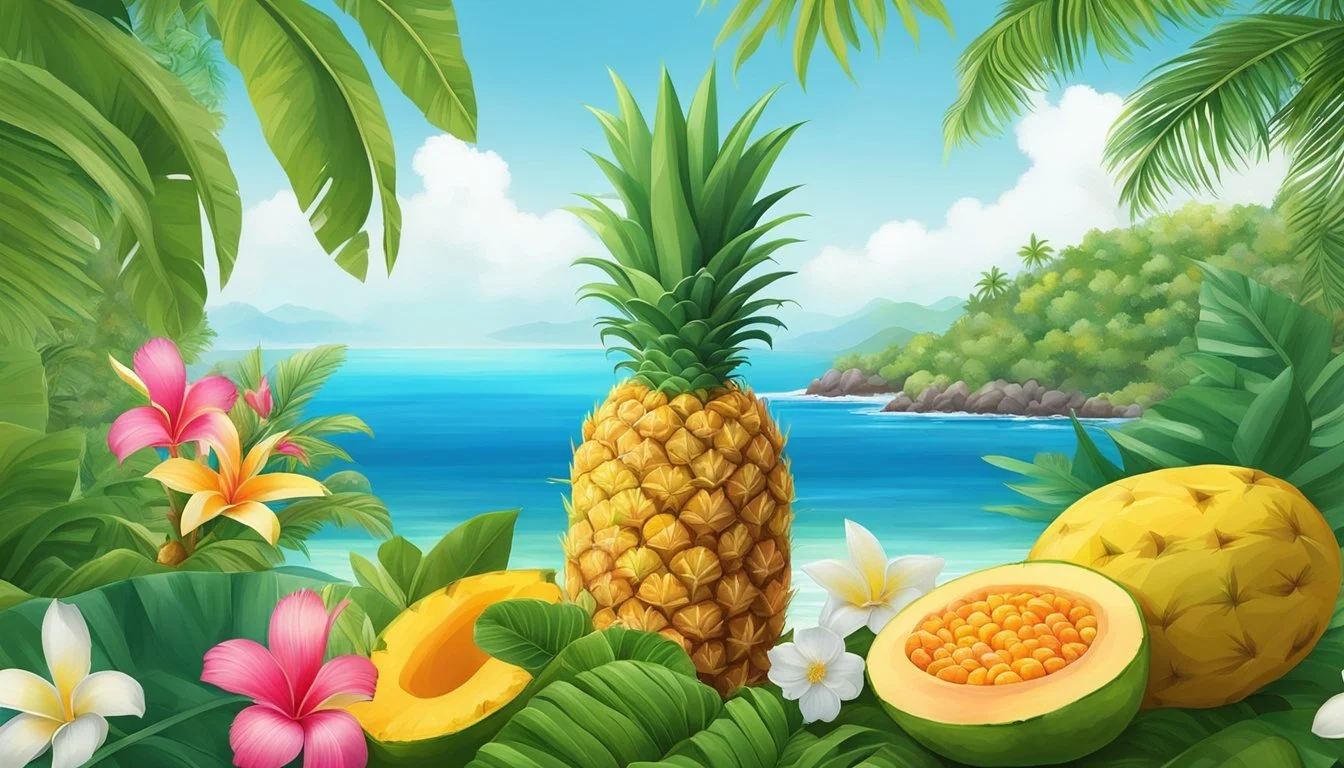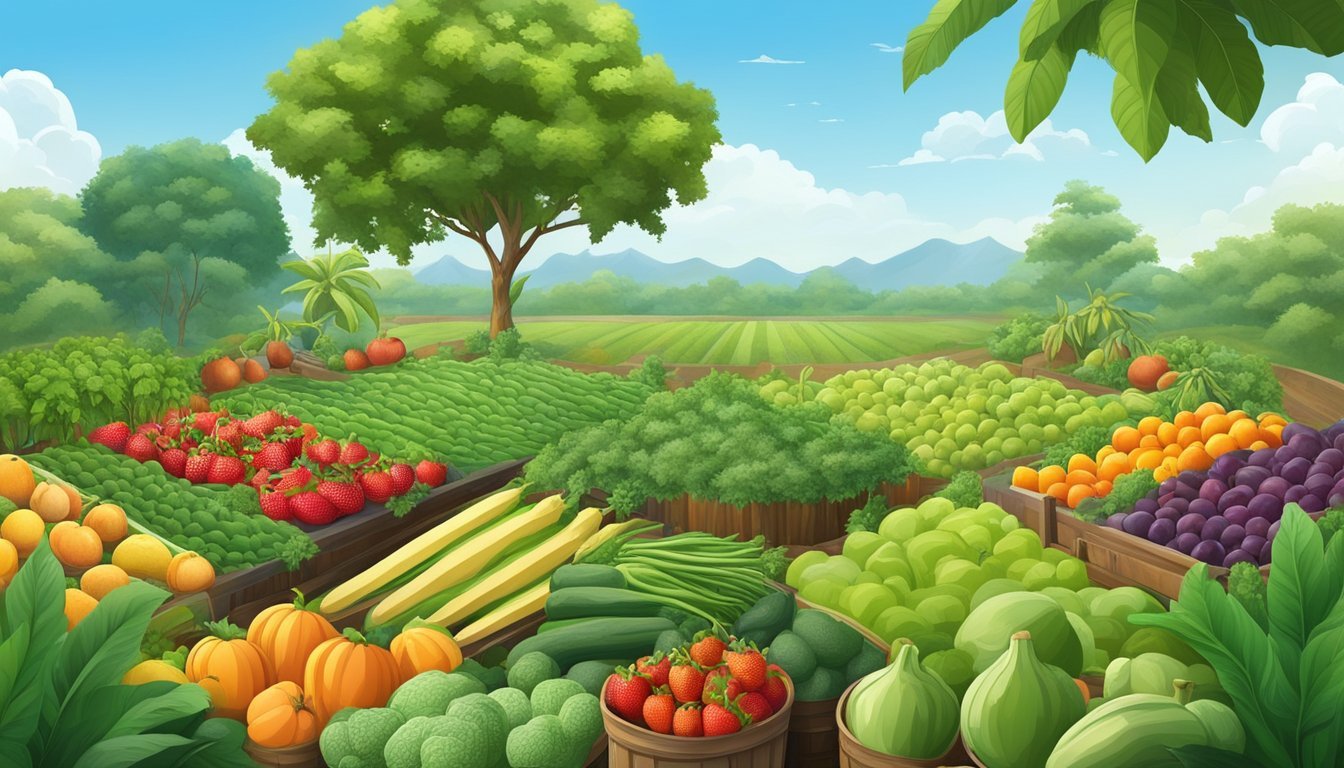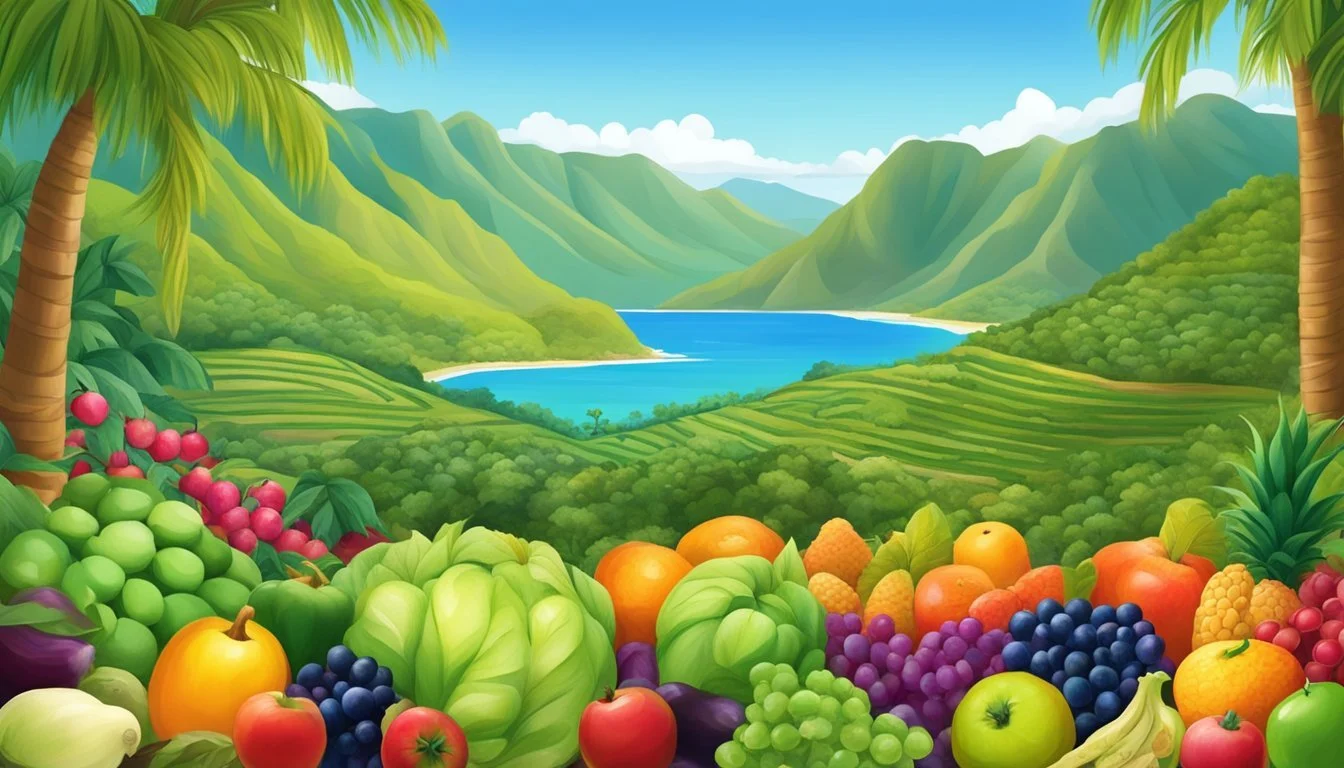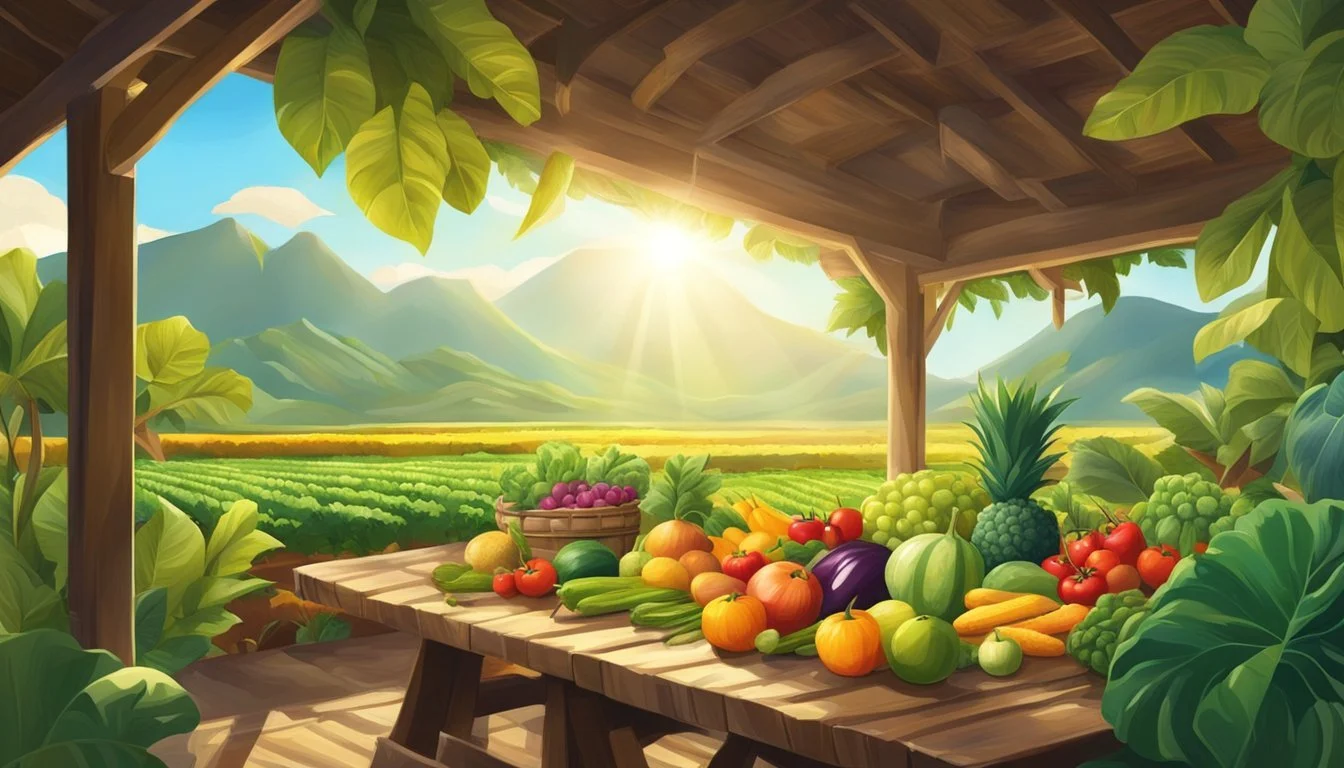Hawaii Seasonal Fruit & Veg Guide
Your Ultimate Fresh Produce Calendar
In Hawaii, the concept of farm to table is not just a trend but a longstanding tradition deeply rooted in the island's culture and way of life. The state's unique climate allows for a year-round growing season, producing an abundant and diverse range of fresh fruits (What wine goes well with fruit?) and vegetables. This bountiful harvest enables chefs and home cooks alike to source ingredients locally, ensuring meals are as fresh as possible while supporting the local agricultural community.
The farm to table movement emphasizes the importance of eating locally-sourced, seasonal produce. In Hawaii, this translates into meals that are often laden with fresh fruits and vegetables picked at the peak of their season. The islands' fertile volcanic soil and diverse microclimates contribute to the wide variety of produce available. From the velvety richness of avocados and the sweet, tropical burst of pineapples and lychee to the subtle sweetness of root vegetables like taro, the Hawaiian palette of flavors is vast and vibrant.
Restaurants and residents alike seek out the freshest local produce to create dishes that are both delicious and environmentally conscious. Seasonality guides inform consumers about peak harvest times, ensuring that the fruits and vegetables on their plates not only taste better but also have a smaller carbon footprint due to reduced shipping distances. By following nature’s cues, Hawaii's farm to table practices deliver an authentic island experience in every bite.
What’s in Season in Hawaii Right Now?
Understanding Hawaii's Unique Climate
Hawaii's climate plays a pivotal role in its agriculture, shaping the variety and availability of fresh produce year-round. The state's climate is predominantly tropical, but it varies dramatically across its islands due to factors like elevation and geography. Generally, Hawaii offers two main seasons: 'Kau,' the warmer, drier season running from May to October, and 'Hooilo,' the cooler, wetter season from November to April.
The Islands’ Microclimates
Notably, Hawaii boasts a range of microclimates including arid, tropical, upcountry temperate, and alpine zones. For instance:
Tropical Climates: Lush vegetation thrives in areas such as Kauai and parts of Maui, where the weather is consistently warm and moist.
Arid Climates: Certain regions on Big Island and Oahu experience low rainfall and higher temperatures.
Temperate Climates: Higher elevations like Upcountry Maui and parts of Big Island offer cooler weather, suited to cultivation of different crops.
Alpine Climates: The summits of Mauna Kea and Haleakala are characterized by colder temperatures and unique ecological conditions.
Seasonal Harvests
These diverse climates affect when fruits and vegetables are harvested. Farmers tailor their practices to the state's climate, ensuring a year-long harvest of a variety of produce. Here is a sample of peak seasons for some Hawaiian produce:
Fruit/Vegetable Peak Season Notes Avocado November - February Locally grown, multiple varieties Banana June - October Thriving in tropical conditions Citrus (e.g., Lime) June - March Abundant during cooler months Lychee May - September High moisture requirements met Root Vegetables Year-Round Diverse climates support growth
Thanks to Hawaii's climate, the state can sustain an impressive farm-to-table movement, with fruits and vegetables often going from harvest to plate within a short time frame, reflecting the rich diversity and freshness of Hawaiian produce.
Seasonal Fruits in Hawaii
Hawaii offers a diverse range of fruits throughout the year, each season bringing a unique selection to the table. This guide helps identify which fruits are at their peak during the different seasons on the islands.
Winter Fruits (January - March)
During the winter months, Hawaii enjoys a variety of fruits that thrive in the cooler weather. Avocados are abundant, with their creamy texture and rich flavor, whereas papayas continue to ripen, offering their sweet taste. One can also find bananas (how long do bananas last?), including the popular apple bananas, which are known for their sweetness and firm texture.
Avocados: January - March
Papayas: Year-round, with a peak in winter
Apple Bananas: Year-round
Spring Fruits (April - June)
As the islands warm up in spring, so does the variety of available fruits. Strawberries come into season, offering their fresh and tart flavors. This is also the beginning of the lychee and mango seasons, starting around April and May respectively, providing a burst of tropical sweetness.
Strawberries: April - June
Lychee: May - September
Mango: March - November
Summer Fruits (July - September)
Summer in Hawaii is perhaps the most vibrant time for fruits, with many reaching their peak. Juicy mangoes continue to be available, while guava and lilikoi (passion fruit) come into season, adding a tangy zest to the fruit selection. One can also enjoy the unique flavors of rambutans and starfruit, with their distinctive appearances and refreshing taste.
Mango: March - November
Guava: July - September
Lilikoi (Passion Fruit): July - September
Rambutans: July - September
Starfruit: July - September
Fall Fruits (October - December)
Heading into fall, the Hawaiian Islands see the emergence of avocados once again, while the apple banana continues to be a mainstay. Additionally, pineapples, although available year-round, tend to be sweeter and are harvested more frequently during these months.
Avocados: November - February
Apple Bananas: Year-round
Pineapples: Year-round, with sweeter harvests in fall
Seasonal Vegetables in Hawaii
Hawaii offers a rich variety of vegetables that thrive in its tropical climate, allowing farmers to cultivate a range of produce for farm-to-table experiences year-round.
Greens and Salads
Hawaii's year-round warm weather provides optimal conditions for an assortment of greens. Lettuce is commonly grown and can be found fresh throughout the year. Kale, a nutrient-dense leafy green, makes its peak appearance typically from November to March, reinforcing salads with its robust texture and flavor.
Peak Seasons:
Lettuce: Year-round
Kale: November – March
Root Vegetables & Gourds
The islands' rich volcanic soil supports the growth of hearty root vegetables and gourds. Carrots flourish in Hawaii, especially during the cooler months from October to March. Radishes, with their peppery taste, are another cool-season crop, and different varieties can be harvested at various times of the year. Squash, including kabocha, offers a sweet taste and is primarily available from summer to fall.
Peak Seasons:
Carrots: October – March
Radishes: Year-round (varies by variety)
Squash: June – December
Tropical Staples
Staple crops such as taro, sweet potatoes (What wine goes well with sweet potatoes?), and cassava are deeply rooted in Hawaiian agriculture. Taro, often used to make the traditional poi, is mostly harvested in the wetter areas of the islands throughout the year. Sweet potatoes, particularly the purple varieties, are also a key component of Hawaiian cuisine and can be harvested throughout the year with spikes in availability from mid-summer to late fall. Cassava, less common but equally important, is typically ready for harvest after about nine months of growth.
Peak Seasons:
Taro: Year-round
Sweet Potatoes: June – November
Cassava: Harvested approximately nine months after planting
Farming Methods and Sustainability
In Hawaii, sustainability in agriculture is not just a practice; it is a necessary approach to ensure the longevity and health of the islands' unique ecosystems. Local farmers adopt various techniques tailored to local fruits and vegetables, focusing on methods that enrich the soil and preserve water resources.
Market Gardening: This approach suits small-scale operations focusing on diverse, high-value crops. It allows farmers to directly respond to local markets with fresh, seasonal produce.
Agroforestry Systems: Integrating trees with crops, agroforestry enhances biodiversity and protects against erosion—a key concern in Hawaii's varied topography.
Tropical Permaculture Techniques: Mimicking natural ecosystems, permaculture in Hawaii utilizes layered planting and relies on natural pest control and fertilization, which promotes soil health and reduces the need for synthetic inputs.
Farmers aim to provide locally grown goods to the community, strengthening the region’s self-sufficiency and reducing the carbon footprint associated with importing food. This farm-to-table supply chain ensures freshness and supports Hawaii's economy.
Here is a brief representation of when certain local fruits typically come into season in Hawaii:
Fruit Seasonality Avocado June - March Citrus Year-round Coconut Year-round
In summary, Hawaii's agricultural sustainability is rooted in a combination of traditional and innovative farming methods that cater to the land's unique requirements, ensuring that locally grown fruits and vegetables are available for generation to come.
Island-Specific Agricultural Highlights
Hawaii's islands each offer a unique tapestry of agricultural products, shaped by the archipelago's diverse climates and soils. From Oahu's variety of farms to Maui's rich agricultural tours and Kauai's commitment to organic farming, the islands are a showcase of sustainable agriculture and bountiful harvests.
Oahu's Farm Diversity
Oahu, often celebrated for its surf and cityscapes, is also a hub for diverse agricultural activities. The island boasts a wealth of farms producing a range of items including coconuts, macadamia nuts (how long do nuts last?), and a multitude of Hawaiian fruits. The Dole Plantation, for instance, symbolizes the island's pineapple legacy.
Maui's Agricultural Tours
Maui is not just about scenic beaches but also about immersive agricultural experiences. Tourists can visit places like Kula, located on the slopes of Haleakala, and indulge in gourmet lunches at farms that open their gates to visitors. Maui Farm tours often showcase tropical fruit and coffee production, providing a hands-on understanding of the island's farming practices.
Kauai's Organic Farms
Known as the Garden Isle, Kauai is a pioneer in organic and sustainable agriculture. Farms on Kauai are recognized for their dedication to organic principles, offering products such as herbs, flowers, and a variety of fruits. These farms not only support the local ecosystem but also cater to a growing demand for organic produce.
Harvesting and Processing Techniques
The harvesting and processing techniques in Hawaii's agricultural sector highlight a blend of traditional methods and modern innovations. These approaches ensure that a variety of fruits and vegetables, such as Hawaiian fruit, coffee, and macadamia nuts, are carefully harvested and processed to maintain quality from farm to table.
Traditional Hawaiian Methods
Hawaiian agriculture has deep roots in tradition, with ancient practices tailored to the archipelago's unique ecosystem. Harvesting and processing techniques for traditional crops like taro and breadfruit involve hand-picking and using simple tools. Trees bearing fruit are often harvested using methods passed down through generations, ensuring the fruit is gathered without causing damage to the trees or the fruit itself. Some fruits, once collected, are processed locally into goods like jam or salsa using time-honored techniques.
Harvested: Manually, with attention to lunar phases
Fruit Trees: Inspected for optimal ripeness
Processing: Traditional drying, open fire-roasting
Modern Farming Innovations
The introduction of modern technology has led to significant advancements in the agricultural sector in Hawaii. Data-driven techniques allow for precise timing in the harvesting of crops like coffee, optimizing bean quality. Macadamia nut farms utilize advanced machinery for cracking the notoriously tough shells, increasing efficiency and yield. Advancements in tech have also led to improved preservation methods such as freezing, ensuring the longevity and freshness of Hawaiian produce.
Coffee: Selective picking guided by ripeness sensors
Macadamia Nut Farm: Mechanical shellers
Tech: Use of cold storage and freezing for preservation
Post-Harvest Handling
Once harvested, proper post-harvest handling is critical to maintain the quality of produce. Hawaiian fruits are carefully sorted and graded to ensure only the best quality for consumption. State-of-the-art drying facilities are utilized to preserve products like coffee and nuts, retaining flavor and extending shelf life. Additionally, modern facilities are employed to transform fresh produce into value-added products like jam and salsa, adhering to stringent quality controls for local and international markets.
Drying: Temperature-controlled environments for optimal moisture reduction
Freezing: Blast freezers for quick preservation
Value-Added Products: Jam and salsa production under sanitary conditions
Farm-to-Table Movement in Hawaii
The farm-to-table concept gains momentum in Hawaii, rooted deeply in the island's cultural and historical aspects of sustainability. Rekindling traditional practices, such as the ahupua'a—an ancient Hawaiian self-sustaining system—this movement has seen steady growth across the islands.
Restaurants and markets alike connect directly with local farms to source seasonal produce, ensuring a fresh dining experience, while bolstering the local economy. The Aina Gourmet Market exemplifies this ethos by offering a variety of local products that celebrate Hawaii's agricultural richness.
Table 1: Common Seasonal Produce in Hawaii
Season Produce Spring Mango, Lychee Summer Avocado, Papaya Fall Breadfruit, Sweet Potato Winter Citrus, Squash
Integrating with restaurants, farmers in Hawaii are essential to menus that frequently change with the seasons. Restaurants partaking in the movement showcase dishes crafted with ingredients at their peak, like the luscious mango or rich avocado, to offer a superior taste profile.
The movement cultivates a system where menus are designed around availability, ensuring that cuisine is not only flavorful but also sustainable. This practice supports local agriculture and provides diners with a genuine taste of Hawaii, making establishments like Aina Gourmet Market and farm-to-table restaurants not just a choice but a culinary destination for conscious and discerning patrons.
Buying and Supporting Local Produce
When it comes to enjoying fresh, local fruit and vegetables in Hawaii, purchasing locally grown produce ensures seasonal variety and supports the local economy. There are several ways consumers can acquire fresh Hawaiian produce while engaging with the community and the environment around them.
Farmers' Markets and Grocery Stores
Farmers' Markets in Hawaii are a bustling hub for locally grown fruits like the renowned Hawaiian papayas, bananas, and pineapples, which can be found in their peak seasons. These venues allow shoppers to buy directly from growers, ensuring the produce is as fresh as it can be. Grocery Stores also stock a range of locally grown items, clearly labeled for those who are deliberate about supporting local agriculture. For instance, Oahu's markets may offer Kahuku Farms' products during the peak seasons.
Key Places and Products:
Farmers' Markets: Papayas (year-round), Bananas (year-round), Pineapples (May to July)
Grocery Stores: Check labels for 'locally grown'
Farm Tours and Agri-Tourism
Agri-tourism is a burgeoning industry, and farms like Kahuku Farms on Oahu offer tours where visitors can learn about local agricultural practices and purchase fresh produce. Maui Pineapple Tours likewise provide a unique experience where visitors can tour fields and facilities to learn about pineapple growing and harvest their own fruit.
Examples of Agri-Tourism:
Kahuku Farms: Farm tours offer insight into local farming and produce.
Maui Pineapple Tours: A hands-on experience to learn and harvest pineapples.
Community-Supported Agriculture (CSA)
Joining a CSA program is an excellent way for individuals to receive a regular supply of fresh, seasonal, and local fruit and vegetables. Members typically get a share of the harvest, which can include a variety of produce, providing a direct link between local farms and households. Co-ops, another form of food distribution, empower a community-focused approach, pooling resources to support local farmers and often providing organic and non-GMO produce options.
CSA Benefits:
Share in the seasonal harvest.
Foster a closer bond between consumer and producer.
By frequenting farmers' markets, participating in agri-tours, and becoming a part of CSA programs or co-ops, consumers can greatly benefit Hawaii's agricultural community, enjoy fresh, seasonal produce, and contribute to the sustainability of local farming.
Recipes and Preparations Featuring Hawaiian Produce
Hawaiian cuisine is a celebration of the islands' finest fruits and vegetables. A popular dish is a fresh Hawaiian salad, incorporating a variety of local ingredients. Because of Hawaii's year-round growing season, fresh produce like sweet pineapple, crisp papayas, and creamy avocados are readily available for a delightful mix of textures and flavors.
Preparation:
Start with a base of mixed greens.
Add chunks of fruits such as mango or pineapple.
Toss in thinly sliced vegetables like cucumber or radish for crunch.
Here's a simple Hawaiian salsa recipe with cilantro that can add a tropical twist to any dish:
1 cup diced tomatoes
1/2 cup diced mango
1/3 cup diced onion
1/4 cup chopped cilantro
Juice of 1 lime
Mix all the ingredients and let the flavors meld for an hour before serving.
Salads can be further enriched with local nuts or shaved coconut, offering a satisfying crunchy contrast. A favorite dressing is a fusion of traditional vinaigrette with a hit of lilikoi (passion fruit) juice for that signature Hawaiian tang.
When it comes to main courses, recipes often feature ulu (breadfruit). This starch can be used in a variety of dishes, from hearty stews to baked goods. Ulu can be cooked similarly to potatoes, making it extremely versatile in Hawaiian recipes.
List of Hawaiian Produce Commonly Used in Recipes:
Fruits: Pineapple, Mango, Papaya, Lilikoi
Vegetables: Ulu, Taro, Sweet Potato
Herbs: Cilantro
Each ingredient reflects the lush landscapes and rich soil of Hawaii, inviting you to experience the islands' bounty in every bite.
Seasonal Challenges and Considerations
In Hawaii's diverse agricultural landscape, seasonal challenges impact both success and sustainability. Farmers must navigate a myriad of issues ranging from pest invasions to the intricacies of global trade, all of which are intensified by the evolving climate.
Pests and Disease Management
Hawaii's tropical climate is conducive to a variety of pests and plant diseases that can threaten crops. Fruit flies, for instance, pose a significant risk to the state's fruit harvest, especially to staples like bananas which peak from June to October. The coffee berry borer impacts coffee farms, another vital Hawaiian crop. Integrated pest management practices are essential for sustaining yield and quality.
Economic and Trade Impacts
The economy of Hawaii is closely tied to its agricultural trade. The availability of local produce such as avocados from November to February and mangoes from March to November is a cornerstone for local markets. Trade policies and fluctuations in the global market can affect the viability of exporting Hawaiian produce, which in turn influences local pricing and farmer revenues.
Climate Change Effects
Climate change poses a significant challenge to Hawaiian agriculture. Rising temperatures and changing precipitation patterns can lead to droughts or unseasonal rains, disrupting the growing seasons of crops like lychee (May to September) and longan (August to October). Adaptation strategies, including modifying planting schedules and employing water conservation measures, are becoming increasingly important for farmers to consider.
Conclusion
Hawaii's rich volcanic soil and tropical climate create a unique environment for a wide array of fruits and vegetables to flourish year-round. Local farmers and the community deeply value sustainability, taking pride in the island's farm-to-table movement. This shared commitment benefits both the environment and the local economy.
Seasonality is key to experiencing the full range of Hawaii's produce. A visit to farmers' markets offers a window into the freshest seasonal offerings. In adherence to sustainability, consumers are encouraged to purchase local produce, supporting the community of growers and minimizing environmental impact.
Sustainability Efforts: By prioritizing locally-grown produce, Hawaii reduces the need for imports, lowers the carbon footprint, and sustains the agricultural landscape.
Community Impact: The farm-to-table concept fosters a closer bond between growers, chefs, and consumers, enhancing the local gastronomy scene.
Embracing local fruits and vegetables not only brings health benefits but also supports traditional Hawaiian farming practices and the islands’ self-sufficiency. Through informed choices, consumers actively contribute to Hawaii's sustainability and the vibrancy of its communities.












